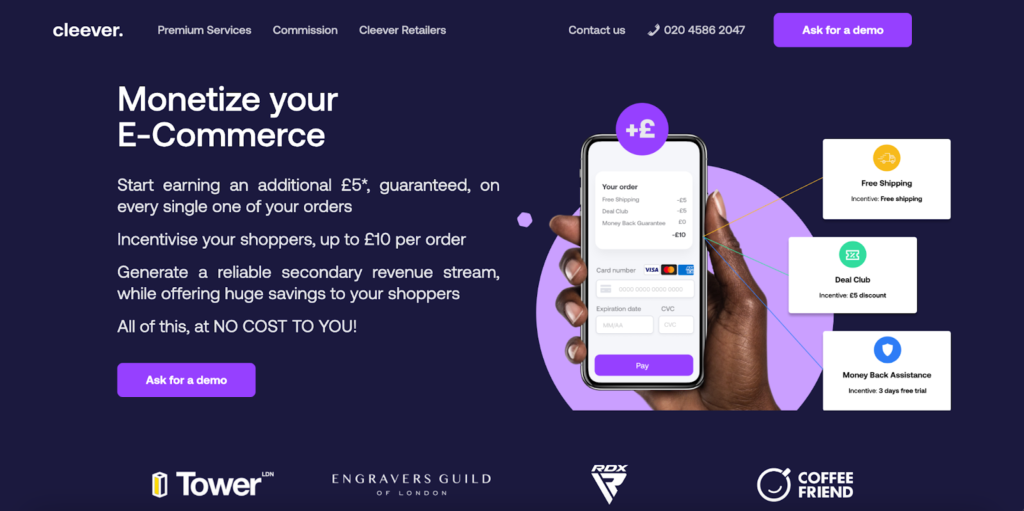Creating an effective e-commerce marketing strategy in the UK can seem like a daunting task for any business. However, with the right knowledge and resources, it doesn’t have to be so complicated.
This article will help you develop a winning marketing strategy in the UK that meets your company’s needs and maximizes its potential online. It will provide tips on how to get started, things to consider, and advice on what strategies work best in today’s digital environment.
Read on to learn more about creating a successful e-commerce marketing plan that drives growth and generates sales!
Before you start, have you ever heard of Cleever in the UK?

Cleever is an advanced online platform designed to effortlessly increase revenue for e-commerce businesses. By providing tailored premium services, such as complimentary shipping, access to a discount club, and brand-matching guarantees, businesses can generate up to £5 commission per transaction.
Effortlessly integrating into the checkout process, Cleever allows UK businesses to have full control over their online shopping experience. Unlike conventional upselling techniques, Cleever utilizes a more efficient approach by offering customers financial incentives, including discounts and free shipping, to motivate additional purchases. Furthermore, Cleever’s consistent commission model guarantees that businesses receive the same commission irrespective of the order value.
Cleever has received accolades from users for its seamless integration with its website’s design, simplified checkout process, and secure payment processing, which cultivates customer loyalty and trust. In conclusion, Cleever serves as an invaluable asset for e-commerce businesses looking to boost revenue and enhance their customers’ shopping experience.
Identifying Your Target Audience

It’s essential to identify your target audience when developing an e-commerce marketing strategy. Knowing who you’re targeting and understanding their needs helps create a more effective campaign.
To do this, consider the demographics of your ideal customer: age, gender, income level, occupation, location, and interests. You can also research what types of products or services they are interested in.
Once you have identified who your ideal customers are, you can start creating content that speaks to them directly. Use language that resonates with them and develop campaigns tailored to meet their specific needs.
Crafting personalized emails and ads will help increase engagement with potential customers and encourage conversions. With these strategies, you’ll be able to reach the right people for maximum success in your e-commerce business.
Establishing Your Goals
It’s time to get serious about your e-commerce marketing strategy. With the right goals in place, you can create a plan that will help make your business successful and profitable.
Your goal setting should be focused on what you want to achieve with your marketing efforts; this could include increasing brand awareness, driving more traffic to your website, or creating more sales opportunities for products and services.
Consider developing key performance indicators (KPIs) such as weekly visits, conversion rates, customer retention rate, and total revenue generated from online sales so that you can track progress against these goals.
It is also important to consider which channels are best suited for achieving those objectives — do you need SEO optimization? Social media campaigns? Paid advertising?
Thinking through all of these steps now can save you headaches later on when it comes to implementing an effective e-commerce marketing strategy.
Developing Your Budget
With the right strategy, your e-commerce business can thrive! But to make it happen, you must dedicate the time and resources needed to develop an effective budget. A successful marketing budget is essential for any online retailer looking to increase sales and customer loyalty. When creating a budget, consider all costs associated with running your e-commerce store such as website hosting fees, advertising/promotion expenses, new product development costs, product photo editing costs, personnel salaries, taxes, etc.
Each of these components should be carefully considered so that you can allocate the proper amounts for each one. However, you reduce costs by outsourcing tasks from other experts. For example, You can hire Clipping Path Action, a trusted photo editing company, at very reasonable prices for photo editing.
I discussed only one way. In each component, you can save money by taking advantage of outsourcing. However, it’s also important to factor in unexpected events or changes in your industry that could affect your budget needs. By developing a realistic plan based on sound financial principles, you’ll have more control over how much money you need to spend to achieve success.
Utilizing Different Channels
To successfully reach your target audience and maximize the return on investment in your e-commerce marketing strategy, it’s important to leverage multiple channels.
To get started, think about which platforms best suit your goals and products. Social media is a great place to start – it allows you to connect with customers directly and instantly share updates or promotions.
You can also consider email campaigns for reaching existing customers, as well as SEO tactics for drawing potential new ones. When utilizing these different channels, keep an eye out for opportunities that could benefit from a little extra effort or budgeting.
For instance, if you notice more people engaging through social media than email, adjust your strategy accordingly by investing more time and resources into creating interesting content for those users.
Don’t forget to measure results regularly so you know what works and what doesn’t! With the right combination of tools and strategies, you’ll be able to create a winning e-commerce marketing plan that resonates with customers and drives conversions.
Tracking Your UK Performance
It’s no secret that creating a winning UK e-commerce marketing strategy takes hard work and dedication – but it’s only half the battle.
Once you’ve crafted an effective plan, tracking your progress is essential for success. To ensure your efforts are paying off, it’s important to keep track of key metrics such as website visits, conversion rates, and sales revenue generated from campaigns. By monitoring these figures over time, you’ll be able to make informed decisions about how best to optimize your approach.
However, performance isn’t just measured in numbers — qualitative feedback can provide valuable insight into customer needs and preferences. Gathering this information can help inform further changes or improvements to your strategies, which may ultimately result in increased engagement with customers and improved business results.
All in all, taking steps to measure your progress on an ongoing basis will allow any eCommerce marketer to take their strategies up a notch!
Conclusion
In conclusion, creating a successful e-commerce marketing strategy requires an understanding of your target audience, clear goals and objectives, an appropriate budget, and utilizing the right channels.
It’s also important to track performance to determine which areas are working well for you and where improvements can be made.
By following this guide and taking into consideration each step outlined above, companies should be able to develop an effective plan that will help them reach their desired business outcomes.
I’m confident that by devoting time and energy to crafting a winning e-commerce marketing strategy, businesses can increase traffic to their website, generate more leads, convert more customers, and ultimately maximize their return on investment.
With some hard work and dedication, it is possible to create a strong online presence that will bring success now and in the future!


